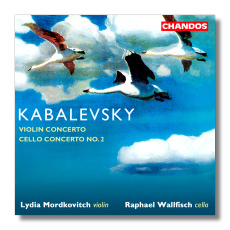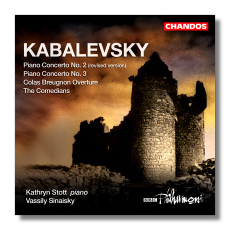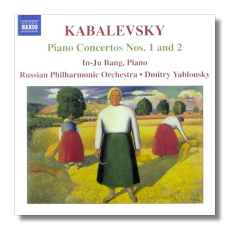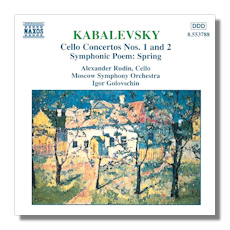
The Internet's Premier Classical Music Source
Related Links
- Kabalevsky Reviews
- Latest Reviews
- More Reviews
-
By Composer
-
Collections
DVD & Blu-ray
Books
Concert Reviews
Articles/Interviews
Software
Audio
Search Amazon
Recommended Links
Site News
 CD Review
CD Review
Dmitry Borisovich Kabalevsky

The Concertos
- Violin Concerto in C Major, Op. 48 (1948)
- Cello Concerto #2, Op. 77 (1964) *
Lydia Mordkovitch, violin
* Raphael Wallfisch, cello
Scottish National Orchestra/Neeme Järvi
* London Philharmonic Orchestra/Bryden Thomson
Chandos CHAN10011 46:10 Reissued 2002 Recorded 1990, * 1987


- Overture to "Colas Breugnon", Op. 24 (1937)
- Piano Concerto #2 in G minor, Op. 23 (1936, rev. 1973) *
- The Comedians, Op. 26 (1939)
- Piano Concerto #3 in D Major "Youth", Op. 50 (1953) *
* Kathryn Stott, piano
BBC Philharmonic Orchestra/Vassily Sinaisky
Chandos CHAN10052 61:45 Recorded 2002


- Piano Concerto #1 in A minor, Op. 9 (1928)
- Piano Concerto #2 in G minor, Op. 23 (1936, rev. 1973)
In-Ju Bang, piano
Russian Philharmonic Orchestra/Dmitry Yablonsky
Naxos 8.557683 56:01 Recorded 2004


- Cello Concerto #1 in G minor, Op. 49 (1948-49)
- Cello Concerto #2, Op. 77 (1964)
- Symphonic Poem "Spring" (Vesna), Op. 65 (1960)
Alexander Rudin, cello
Moscow Symphony Orchestra/Igor Golovschin
Naxos 8.553788 56:43 Recorded 1996
Comparisons:
Cello Concerto #2 – Shafran/Kabalevsky/Cello Classics
Violin Concerto – Oistrakh/Kabalevsky/Classica D'Oro, Shaham/Pletnev/DG
Dmitry Kabalevsky (1904-1987) has not received very good press over the decades. He is often referred to as a 'Soviet' composer, because he supported the Soviet regime and even became a member of the Communist Party. While Shostakovich and other Russian composers were dodging the oppressive arm of the Soviet dictatorship, Kabalevsky embraced the arm and made a secure spot for himself within the system. As the story goes, he even managed to get his name taken off a list of unsavory composers in 1948 and replaced it with the name of another composer. Other choice remarks about Kabalevsky are that he was self-serving, sly, and opportunistic to the extreme.
Of course, the above perceptions do not address Kabalevsky's musical style or level of inspiration. However, these perceptions certainly tend to lead to less than sterling opinions of his music. It is widely thought that Kabalevsky churned out banal music in tribute to the oppressive regime just to appease the authorities. As it currently stands, both the man and his music are in the somewhat distasteful category. Yet, some of Kabalevsky's music gets programmed and recorded with regularity. It all goes to prove that good music can overcome the low personality of its author, and Kabalevsky was definitely a fine composer.
Listening to the recordings in the heading paints a fairly accurate picture of Kabalevsky's musical style, artistry, and adherence to the Soviet thought-system. Some of Kabalevsky's music does veer toward the simplistic glorification of the Soviet dictatorship. The 3rd Movement of the Violin Concerto is definitely in this vein, offering slap-happy and mindless homage. At the other end are works such as the Cello Concerto #2 that are rich in emotional depth and honesty of expression.
As I hear it, there are two ingredients that raise Kabalevsky's music above the average middle period Soviet composer. One is his exceptional gift for orchestration (particularly orchestral colours), and the other is his ability to come up with a host of immediately fetching melodies on just a moment's notice. Kabalevsky reminds me greatly of Mozart who is the master of constant strings of fetching tunes, the main difference between the two being that Mozart's melodies have true staying power.
Let's start off with the Chandos reissue of Kabalevsky's Violin Concerto and Cello Concerto #2. The Violin Concerto is the most popular of his works for solo instrument and orchestra; it's immediately likeable with catchy melodies, soulful refrains, and exciting/tense virtuosity. Although composed in the middle of the 20th century, the work hasn't a trace of dissonance and harkens back to the heart of the Romantic era.
In the typical three movements, the 1st Movement Allegro molto e con brio is high-octane music loaded with thrills and strong drive; the mood is not gloomy but dominated by a soulful character. The 2nd Movement Andante cantabile is in ABA form; the first section is in B Flat minor and has a warm and cantabile theme, while the second section in A Major offers enhanced vigor. In the return to the original cantabile theme, Kabalevsky decorates the music with elegant scales and other embellishments. These first two movements are quite attractive and do possess musical substance, although their melodies are not particularly captivating. The 3rd Movement Vivace giocoso is a bit of a disappointment with its obvious slap-happy homage to the Soviet regime; given its minimal substance, sound quality takes center stage.
In the Violin Concerto's discography, David Oistrakh is the dominant and mandatory figure. Kabalevsky wrote the work for Oistrakh to play, and his performance captures the colors and spirit of the music better than any other on record. To her credit, Mordkovitch is not far behind; she well identifies with the soulful 1st Movement, plays the 2nd Movement beautifully, and engages in a wealth of tonal shading. Järvi offers expert support, driving his orchestra one minute and luxuriating the next. With exceptional sound, this is a highly recommendable version. I have included the Shaham/Pletnev recording for comparison solely as an example of how not to play the work. Shaham's playing is rather boring with little characterization or variety of tone, and the 2nd Movement tempo is too fast to allow the music sufficient breathing room.
The Chandos coupling is Kabalevsky's Cello Concerto #2, a work that I consider the composer's best and a must for Russian music enthusiasts. Instead of the superficial utterances and glitter of the Violin Concerto, Kabalevsky's Cello Concerto #2 offers an amalgam of mournful phrasing, harrowing experiences, satiric wit, and tremendous tension and excitement. These are real emotions that Kabalevsky is throwing our way, a rather rare event in his musical repertoire. Particularly memorable are the harrowing plucked strings of the 1st Movement and the satirical bite of the alto sax in the 2nd Movement. However, be assured that every moment of this 30 minute work is compelling.
Raphael Wallfisch and the late Bryden Thomson give us excellent performances fully up to the Mordkovitch/Järvi coupling. Thomson doesn't get the greatest tension out of his orchestra, but the glorious Chandos sound largely mitigates any deficit. Of course, the Shafran/Kabalevsky collaboration is mandatory listening for the added terror it conveys, but this historical recording can't possibly bring out the orchestral colors as vividly as the Chandos.
Let's move along now to the two Kabalevsky Cello Concertos on Naxos played by soloist Alexander Rudin with Igor Golovschin conducting the Moscow Symphony Orchestra. Although the sound is somewhat constricted in comparison to the Chandos version of Cello Concerto #2, Golovschin offers greater tension than Thomson, and tension is one of the key features of the work. There is also quite a difference between the Chandos and Naxos couplings. As discussed earlier in the review, the Violin Concerto is a flashy piece of music that sometimes gets lost in banal declarations and surface glitter. In contrast, Kabalevsky's Cello Concerto #1, written in the same year as his Violin Concerto, is a rather soothing work without big climaxes although its 3rd Movement does veer toward the flashy side of life. For my money, I'd select the Naxos before the Chandos recording. The Naxos disc also offers the symphonic poem "Vesna"; although a nice piece, I don't consider it of much significance in choosing the Naxos.
That leaves two discs of Kabalevsky Piano Concertos, and again the choice is between Chandos and Naxos which together cover all Kabalevsky's piano concertos except for his 4th composed in 1972. Sad to say, the 1st and 3rd Piano Concertos have little to offer; each possesses little cohesion, and the musical inspiration is rather low. I am not surprised with the sub-par results for the very early Concerto #1, but the equally deficient Concerto #3 baffles me. On the plus side, Concerto #2 is an excellent work: fetching melodies with musical arguments proceeding in a natural manner.
The Chandos piano concertos disc gets the nod over the Naxos for two reasons. First, the Chandos soundstage is fantastic and a "sonic spectacular". Although detail is not as fine as in a typical SACD recording, the expansiveness of the soundstage matches any SACD I have heard; the Naxos sound is acceptable but a poor substitute for the Chandos. Second, Vassily Sinaisky offers tremendous propulsion in the outer movements of Piano Concerto #2. Listening to Yablonsky's reading, you wouldn't know that there was any potential for strong drive; in general, Yablonsky and excitement often don't merge. As for the pianists, I didn't notice any strong differences.
Don's Conclusions:
- The Cello Concerto #2 is a masterpiece. Kabalevsky's other concertos are not
- With the above in mind, top honors among the four reviewed discs go to the Naxos recording of Kabalevsky's two Cello Concertos. The Chandos disc of Cello Concerto #2 and the Violin Concerto is not far behind with excellent performances and sonics
- If the piano concerto is your favored genre, Chandos is the path to take. In addition to better conducting and sonics than offered on the Naxos disc, there's also the advantage of exceptional interpretations of the two Chandos fillers – the Overture to Colas Breugnon and The Comedians
- In the historical arena, Oistrakh and Shafran are the standards by which all other performers are measured
Copyright © 2006, Don Satz




















